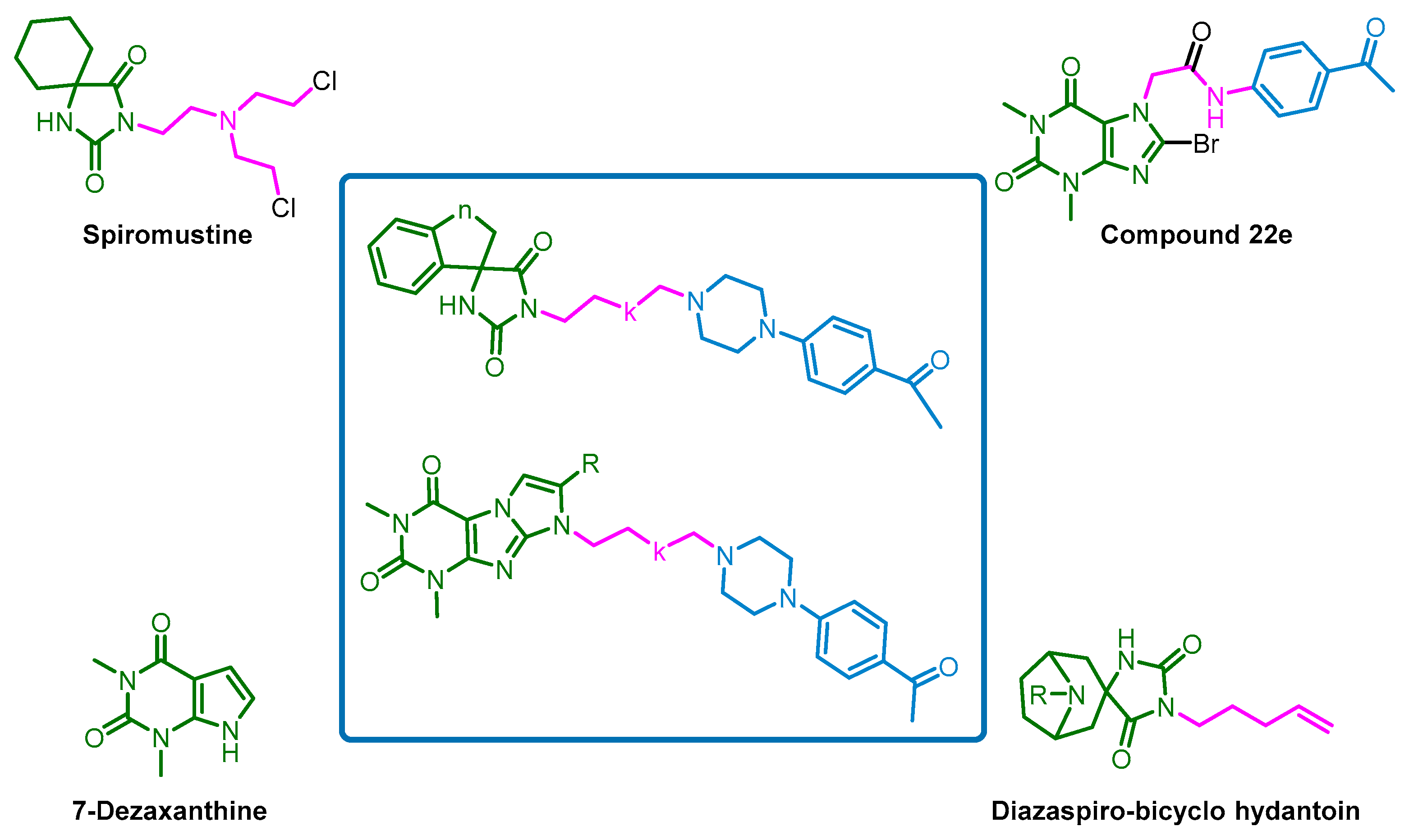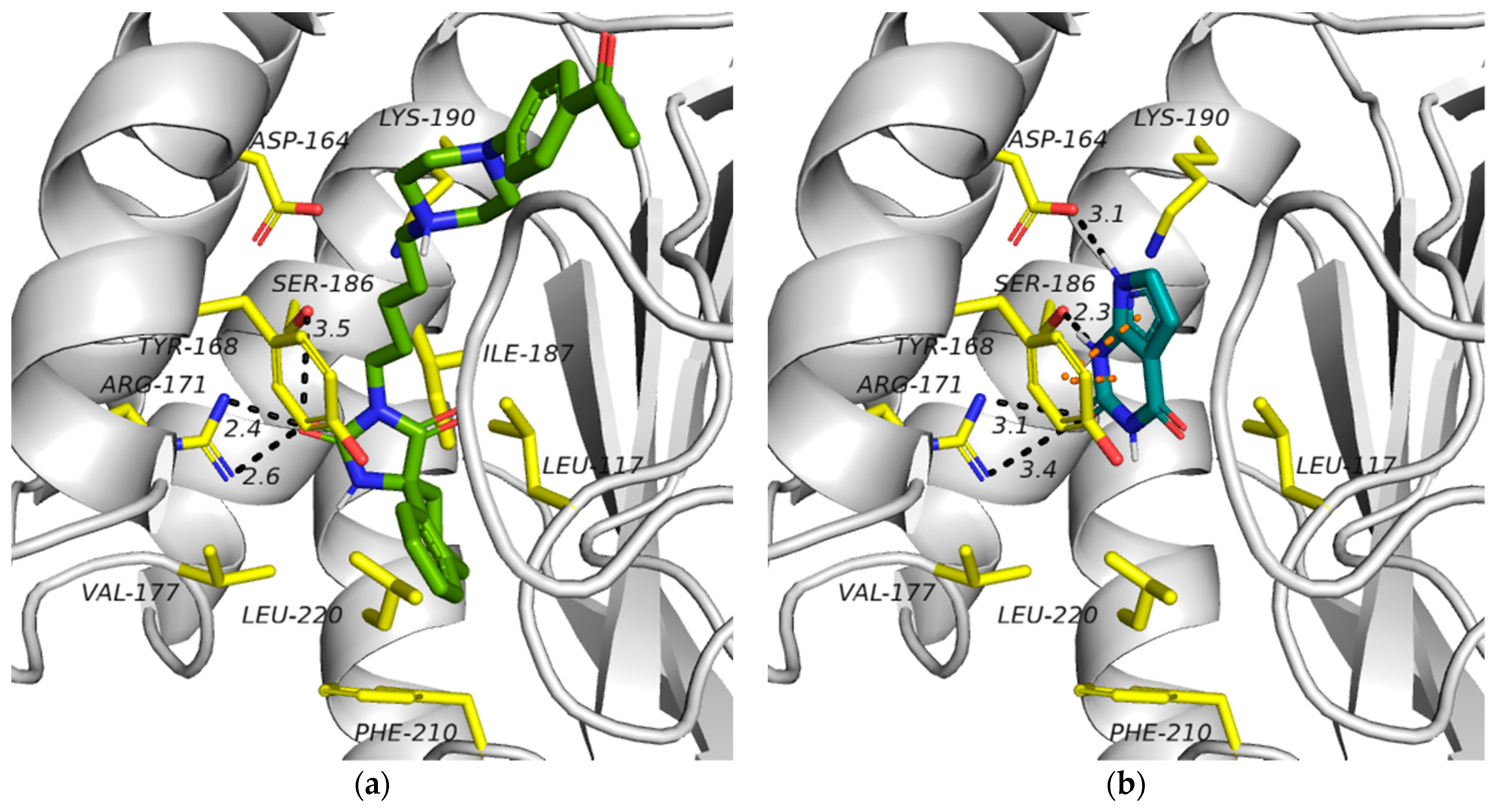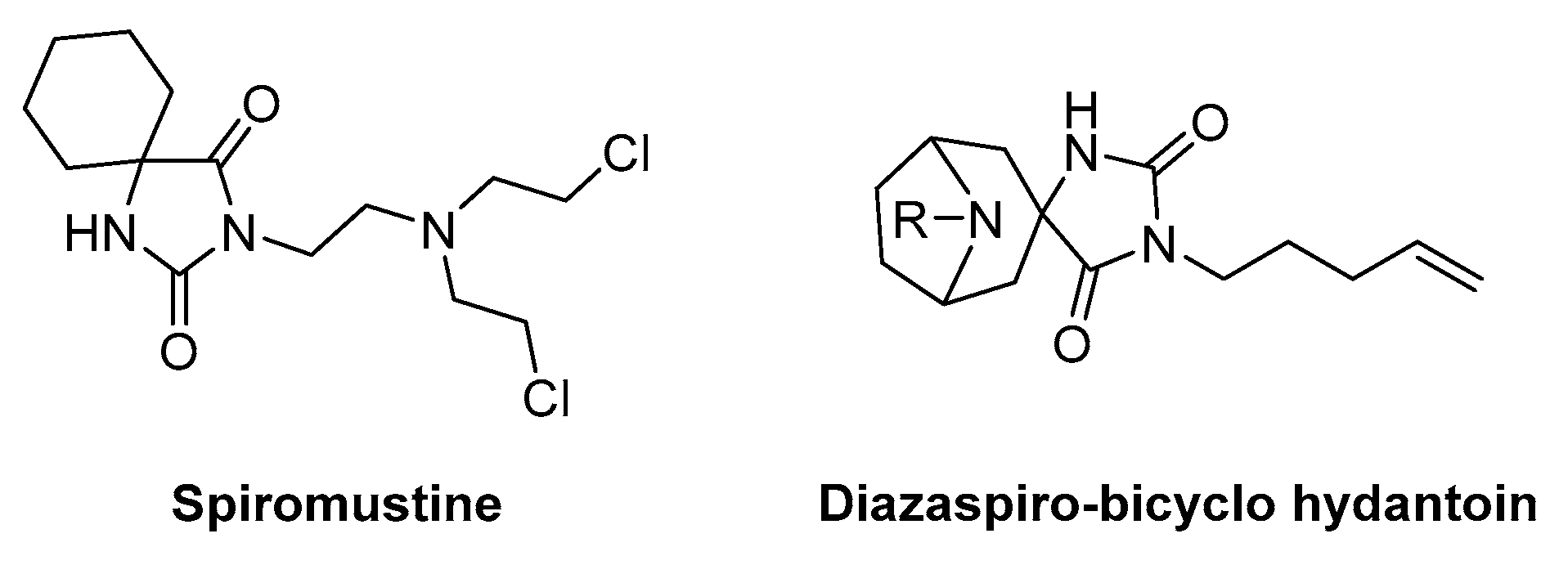Design, Synthesis, and In Vitro Antiproliferative Activity of Hydantoin and Purine Derivatives with the 4-Acetylphenylpiperazinylalkyl Moiety
Abstract
:1. Introduction
2. Materials and Methods
2.1. Chemistry
2.1.1. General Procedure for Obtaining Spirohydantoin (I–IV)
2.1.2. General Procedure for Alkylation of Spirohydantoin (V–XII)
2.1.3. (R,S)-1-(4-Bromobutyl)-1′,3′-dihydro-2H,5H-spiro[imidazolidine-4,2′-indene]-2,5-dione (VIII)
2.1.4. (R,S)-1-(5-Bromopentyl)-1′,3′-dihydro-2H,5H-spiro[imidazolidine-4,2′-indene]-2,5-dione (XI)
2.1.5. (R,S)-1-(5-Bromopentyl)-3′,4′-dihydro-1′H,2H,5H-spiro[imidazolidine-4,2′-naftalene]-2,5-dione (XII)
2.2. General Procedure for Obtaining the Final Compounds 1–8
2.2.1. (R,S)-1-(4-(4-(4-Acetylphenyl)piperazin-1-yl)butyl)-2′,3′-dihydrospiro[imidazolidine-4,1′-indene]-2,5-dione (1)
2.2.2. (R,S)-1-(5-(4-(4-Acetylphenyl)piperazin-1-yl)pentyl)-2′,3′-dihydrospiro[imidazolidine-4,1′-indene]-2,5-dione (2)
2.2.3. (R,S)-1-(4-(4-(4-Acetylphenyl)piperazin-1-yl)butyl)-3′,4′-dihydro-2′H-spiro[imidazolidine-4,1′-naphthalene]-2,5-dione (3)
2.2.4. (R,S)-1-(5-(4-(4-Acetylphenyl)piperazin-1-yl)pentyl)-3′,4′-dihydro-2′H-spiro[imidazolidine-4,1′-naphthalene]-2,5-dione (4)
2.2.5. (R,S)-1-{4-[4-(4-Acetylophenyl)piperazyn-1-yl]butyl}-1′,3′-dihydro-2H,5H-spiro[imidazolidine-4,2′-indene]-2,5-dione (5)
2.2.6. (R,S)-1-{5-[4-(4-Acetylophenyl)piperazyn-1-yl]pentyl}-1′,3′-dihydro-2H,5H-spiro[imidazolidine-4,2′-indene]-2,5-dione (6)
2.2.7. (R,S)-1-{4-[4-(4-Acetylophenyl)piperazyn-1-yl]butyl}-3′,4′-dihydro-2H,2′H,5H-spiro[imidazolidine-4,1′-naftalene]-2,5-dione (7)
2.2.8. (R,S)-1-{5-[4-(4-Acetylophenyl)piperazin-1-yl]pentyl}-3′,4′-dihydro-2H,2′H,5H-spiro[imidazolidine-4,1′-naftalene]-2,5-dione (8)
2.3. General Procedure for Obtaining the Final Compounds 9–11
2.3.1. 8-(4-(4-(4-Acetylphenyl)piperazin-1-yl)butyl)-1,3-dimethyl-1H-imidazo[2,1-f]purine-2,4(3H,8H)-dione (9)
2.3.2. 8-(4-(4-(4-Acetylphenyl)piperazin-1-yl)butyl)-1,3,7-trimethyl-1H-imidazo[2,1-f]purine-2,4(3H,8H)-dione (10)
2.3.3. 8-(5-(4-(4-Acetylphenyl)piperazin-1-yl)pentyl)-1,3-dimethyl-1H-imidazo[2,1-f]purine-2,4(3H,8H)-dione (11)
2.4. General Procedure for Obtaining the Final Compounds 12–14
2.4.1. 9-(4-(4-(4-Acetylphenyl)piperazin-1-yl)butyl)-1,3-dimethylpyrimido[2,1-f]purine-2,4,8(1H,3H,9H)-trione (12)
2.4.2. 9-(5-(4-(4-Acetylphenyl)piperazin-1-yl)pentyl)-1,3-dimethylpyrimido[2,1-f]purine-2,4,8(1H,3H,9H)-trione (13)
2.4.3. 9-(4-(4-(4-Acetylphenyl)piperazin-1-yl)butyl)-7-bromo-1,3-dimethylpyrimido[2,1-f]purine-2,4,8(1H,3H,9H)-trione (14)
2.5. Cell Culture Condition for MTT Assay
2.6. MTT Assay
2.7. Determination of Hemolytic Activity
2.8. Thymidine Phosphorylase Inhibition
2.9. Docking Studies
3. Results
3.1. Chemistry
3.2. Biological Study
3.3. Hemolytic Activity
3.4. Thymidine Phosphorylase Inhibition Assay
3.5. Docking Studies to the Thymidine Phosphorylase Active Site
4. Discussion
5. Conclusions
Supplementary Materials
Author Contributions
Funding
Institutional Review Board Statement
Informed Consent Statement
Data Availability Statement
Conflicts of Interest
References
- Thurston, D.E.; Pysz, I. Chemistry and Pharmacology of Anticancer Drugs, 2nd ed.; CRC Press: Boca Raton, FL, USA, 2021; p. 47. [Google Scholar]
- Mortality and Global Health Estimates. Available online: https://www.who.int/data/gho/data/themes/mortality-and-global-health-estimates (accessed on 7 April 2021).
- Mattiuzzi, C.; Lippi, G. Current cancer epidemiology. J. Epidemiol. Glob. Health 2019, 9, 217–222. [Google Scholar] [CrossRef] [PubMed] [Green Version]
- Jaromin, A.; Czopek, A.; Parapini, S.; Basilico, N.; Misiak, E.; Gubernator, J.; Zagórska, A. Synthesis and antiplasmodial activity of novel bioinspired imidazolidinedione derivatives. Biomolecules 2021, 11, 1–13. [Google Scholar]
- Shoemaker, D.D.; O’Dwyer, P.J.; Marsoni, S.; Plowman, J.; Davignon, J.P.; Davis, R.D. Spiromustine: A new agent entering clinical trials. Investig. New Drugs 1983, 1, 303–308. [Google Scholar] [CrossRef] [PubMed]
- Obradović, A.; Matić, M.; Ognjanović, B.; Vuković, N.; Vukić, M.; Đurđević, P.; Ušćumlić, G.; Božić, B.; Nedeljković, B.B. Anti-Tumor Mechanisms of Novel 3-(4-Substituted Benzyl)-5-Isopropil-5- Phenylhydantoin Derivatives in Human Colon Cancer Cell Line. Anticancer Agents Med. Chem. 2019, 19, 1491–1502. [Google Scholar] [CrossRef] [PubMed]
- Rajic, Z.; Zorc, B.; Raic-Malic, S.; Ester, K.; Kralj, M.; Pavelic, K.; Balzarini, J.; De Clercq, E.; Mintas, M. Hydantoin Derivatives of L- and D-amino acids: Synthesis and Evaluation of Their Antiviral and Antitumoral Activity. Molecules 2006, 11, 837–848. [Google Scholar] [CrossRef] [Green Version]
- Ananda Kumar, C.S.; Kavitha, C.V.; Vinaya, K.; Prasad, S.B.B.; Thimmegowda, N.R.; Chandrappa, S.; Raghavan, S.C.; Rangappa, K.S. Synthesis and in vitro cytotoxic evaluation of novel diazaspiro bicyclo hydantoin derivatives in human leukemia cells: A SAR study. Investig. New Drugs 2009, 27, 327–337. [Google Scholar] [CrossRef]
- Kavitha, C.V.; Nambiar, M.; Kumar, C.S.A.; Choudhary, B.; Muniyappa, K.; Rangappa, K.S.; Raghavan, S.C. Novel derivatives of spirohydantoin induce growth inhibition followed by apoptosis in leukemia cells. Biochem. Pharmacol. 2009, 77, 348–363. [Google Scholar] [CrossRef]
- Lamanna, N.; Weiss, M. Purine analogs in leukemia. Adv. Pharmacol. 2004, 51, 107–125. [Google Scholar]
- Kane, B.J.; Kuhn, J.G.; Roush, M.K. Pentostatin: An adenosine deaminase inhibitor for the treatment of hairy cell leukemia. Ann. Pharmacother. 1992, 26, 939–947. [Google Scholar] [CrossRef]
- Maltzman, J.S.; Koretzky, G.A. Azathioprine: Old drug, new actions. J. Clin. Investig. 2003, 111, 1122–1124. [Google Scholar] [CrossRef]
- Abraham, R.T.; Acquarone, M.; Andersen, A.; Asensi, A.; Bellé, R.; Berger, F.; Bergounioux, C.; Brunn, G.; Buquet-Fagot, C.; Fagot, D.; et al. Cellular effects of olomoucine, an inhibitor of cyclin-dependent kinases. Biol. Cell. 1995, 83, 105–120. [Google Scholar] [CrossRef]
- Mohamed, A.R.; El Kerdawy, A.M.; George, R.F.; Georgey, H.H.; Gawad, N.M.A. Design, synthesis and in silico insights of new 7,8-disubstituted-1,3-dimethyl-1H-purine-2,6(3H,7H)-dione derivatives with potent anticancer and multi-kinase inhibitory activities. Bioorganic Chem. 2021, 107, 104569. [Google Scholar] [CrossRef] [PubMed]
- Sawyers, C. Targeted cancer therapy. Nature 2004, 432, 294–297. [Google Scholar] [CrossRef] [PubMed]
- Hotchkiss, K.A.; Ashton, A.W.; Schwartz, E.L. Thymidine phosphorylase and 2-deoxyribose stimulate human endothelial cell migration by specific activation of the integrins α5β1 and αvβ3. J. Biol. Chem. 2003, 278, 19272–19279. [Google Scholar] [CrossRef] [Green Version]
- Balzarini, J.; Gamboa, A.E.; Esnouf, R.; Liekens, S.; Neyts, J.; De Clercq, E.; Camarasa, M.-J.; Pérez-Pérez, M.-J. 7-Deazaxanthine, a novel prototype inhibitor of thymidine phosphorylase. FEBS Lett. 1998, 438, 91–95. [Google Scholar] [CrossRef] [Green Version]
- Fiorino, F.; Severino, B.; Magli, E.; Ciano, A.; Caliendo, G.; Santagada, V.; Frecentese, F.; Perissutti, E. 5-HT1A receptor: An old target as a new attractive tool in drug discovery from central nervous system to cancer. J. Med. Chem. 2014, 57, 4407–4426. [Google Scholar] [CrossRef]
- Byrtus, H.; Pawłowski, M.; Czopek, A.; Bojarski, A.J.; Duszyńska, B.; Nowak, G.; Kłodzińska, A.; Tatarczyńska, E.; Wesołowska, A.; Chojnacka-Wójcik, E. Synthesis and 5-HT1A, 5-HT2A receptor activity of new β-tetralonohydantoins. Eur. J. Med. Chem. 2005, 40, 820–829. [Google Scholar] [CrossRef] [PubMed]
- Czopek, A.; Kołaczkowski, M.; Bucki, A.; Byrtus, H.; Pawłowski, M.; Kazek, G.; Bojarski, A.J.; Piaskowska, A.; Kalinowska-Tłücik, J.; Partyka, A.; et al. Novel spirohydantoin derivative as a potent multireceptor-active antipsychotic and antidepressant agent. Bioorganic Med. Chem. 2015, 23, 3436–3447. [Google Scholar] [CrossRef]
- Zagórska, A.; Jurczyk, S.; Pawłowski, M.; Dybała, M.; Nowak, G.; Tatarczyńska, E.; Nikiforuk, A.; Chojnacka-Wójcik, E. Synthesis and preliminary pharmacological evaluation of imidazo[2,1-f]purine-2,4-dione derivatives. Eur. J. Med. Chem. 2009, 44, 4288–4296. [Google Scholar] [CrossRef]
- Zagórska, A.; Gryzło, B.; Satała, G.; Bojarski, A.J.; Gluch-Lutwin, M.; Mordyl, B.; Kazek, G.; Pawłowski, M. Receptor affinity and phosphodiesterases 4B and 10A activity of octahydro- and 6,7-dimethoxy-3,4-dihydro-isoquinolin-2-(1H)-yl-alkyl derivatives of imidazo- and pyrimidino[2,1-f]purines. Acta Polinae Pharm. 2016, 73, 369–377. [Google Scholar]
- Leibovitz, A.; Stinson, J.C.; McCombs, W.B.; McCoy, C.E.; Mazur, K.C.; Mabry, N.D. Classification of Human Colorectal Adenocarcinoma Cell Lines. Cancer Res. 1976, 36, 4562–4569. [Google Scholar]
- Jaromin, A.; Korycińska, M.; Piętka-Ottlik, M.; Musiał, W.; Peczyńska-Czoch, W.; Kaczmarek, Ł.; Kozubek, A. Membrane Perturbations Induced by New Analogs of Neocryptolepine. Biol. Pharm. Bull. 2012, 35, 1432–1439. [Google Scholar] [CrossRef] [Green Version]
- Krenitsky, T.A.; Bushby, S.R.M. Stabilized Thymidine Phosphorylase Formulation. U.S. Patent 4,178,212, 5 July 1979. [Google Scholar]
- Berman, H.M.; Westbrook, J.; Feng, Z.; Gilliland, G.; Bhat, T.N.; Weissig, H.; Shindyalov, I.N.; Bourne, P.E. The Protein Data Bank. Nucleic Acids Res. 2000, 28, 235–242. [Google Scholar] [CrossRef] [PubMed] [Green Version]
- Timofeev, V.I.; Abramchik, Y.A.; Fateev, I.V.; Zhukhlistova, N.E.; Murav’eva, T.I.; Kuranova, I.P.; Esipov, R.S. Three-dimensional structure of thymidine phosphorylase from E. coli in complex with 3′-azido-2′-fluoro-2′,3′- dideoxyuridine. Crystallogr. Rep. 2013, 58, 842–853. [Google Scholar] [CrossRef]
- Shahzad, S.A.; Yar, M.; Khan, Z.A.; Shahzadi, L.; Naqvi, S.A.R.; Mahmood, A.; Ullah, S.; Shaikh, A.J.; Sherazi, T.A.; Bale, A.T.; et al. Identification of 1,2,4-triazoles as new thymidine phosphorylase inhibitors: Future anti-tumor drugs. Bioorganic Chem. 2019, 85, 209–220. [Google Scholar] [CrossRef] [PubMed]
- Norman, R.A.; Barry, S.T.; Bate, M.; Breed, J.; Colls, J.G.; Ernill, R.J.; Luke, R.W.A.; Minshull, C.A.; McAlister, M.S.B.; McCall, E.J.; et al. Crystal structure of human thymidine phosphorylase in complex with a small molecule inhibitor. Structure 2004, 12, 75–84. [Google Scholar] [CrossRef]
- Su, M.; Xia, D.; Teng, P.; Nimmagadda, A.; Zhang, C.; Odom, T.; Cao, A.; Hu, Y.; Cai, J. Membrane-Active Hydantoin Derivatives as Antibiotic Agents. J. Med. Chem. 2017, 60, 8456–8465. [Google Scholar] [CrossRef] [PubMed] [Green Version]





| Compd | Cell Lines | ||||||
|---|---|---|---|---|---|---|---|
| SW480 c | SW 620 d | PC3 e | HaCaT f | ||||
| IC50 a | SI b | IC50 | SI | IC50 | SI | IC50 | |
| 1 | 54.18 ± 3.89 | 0.77 | 67.05 ± 5.24 | 0.62 | 57.62 ± 5.86 | 0.72 | 41.75 ± 7.62 |
| 2 | 40.68 ± 3.54 | 0.55 | 43.12 ± 4.41 | 0.52 | 36.23 ± 4.98 | 0.62 | 22.55 ± 2.69 |
| 3 | 129.35 ± 10.85 | 0.88 | 104.15 ± 7.36 | 1.09 | 64.45 ± 6.76 | 1.76 | 113.53 ± 8.93 |
| 4 | 16.8 ± 2.37 | 2.19 | 12.9 ± 3.16 | 2.85 | 20.58 ± 3.35 | 1.79 | 36.78 ± 5.32 |
| 5 | 102.09 ± 2.37 | - | >200 | - | >200 | - | >200 |
| 6 | 53.67 ± 7.78 | 2.95 | 78.34 ± 4.76 | 2.02 | 95.12 ± 8.4 | 1.67 | 158.51 ± 14.12 |
| 7 | 103.33 ± 9.36 | 1.61 | 79.92 ± 5.12 | 2.08 | 88.9 ± 3.64 | 1.87 | 166.61 ± 1.58 |
| 8 | 62.17 ± 7.48 | 1.42 | 84.3 ± 4.87 | 1.05 | 42.8 ± 3.64 | 2.06 | 88.32 ± 3.27 |
| 9 | 153.34 ± 11.29 | 0.47 | 144.64 ± 3.76 | 0.50 | 101.26 ± 15.37 | 0.72 | 72.78 ± 6.08 |
| 10 | >200 | - | 130.67 ± 12.64 | 0.73 | 86.12 ± 9.85 | 1.11 | 96.06 ± 5.32 |
| 11 | >200 | - | 97.69 ± 10.74 | 0.60 | 60.28 ± 0.4 | 0.97 | 58.65 ± 4.91 |
| 12 | >200 | - | 169.28 ± 22.91 | 0.49 | 71.85 ± 9.85 | 1.17 | 83.91 ± 4.20 |
| 13 | >200 | - | >200 | - | 94.2 ± 8.36 | 1.33 | 125.84 ± 14.35 |
| 14 | >200 | - | >200 | - | 90.97 ± 5.86 | 1.06 | 96.45 ± 4.93 |
| Doxorubicin | 0.29 ± 0.08 | 0.81 | 0.31 ± 0.07 | 0.76 | 0.59 ± 0.02 | 0.40 | 0.24 ± 0.03 |
| Compd | Cell Lines | ||||||
|---|---|---|---|---|---|---|---|
| SW480 c | SW 620 dc | PC3 e | HMEC-1 f | ||||
| IC50 a | SI b | IC50 | SI | IC50 | SI | IC50 | |
| 4 | 16.8 ± 2.37 | 8.88 | 12.9 ± 3.16 | 11.57 | 20.58 ± 3.35 | 7.25 | 149.29 ± 10.63 |
Publisher’s Note: MDPI stays neutral with regard to jurisdictional claims in published maps and institutional affiliations. |
© 2021 by the authors. Licensee MDPI, Basel, Switzerland. This article is an open access article distributed under the terms and conditions of the Creative Commons Attribution (CC BY) license (https://creativecommons.org/licenses/by/4.0/).
Share and Cite
Zagórska, A.; Czopek, A.; Jaromin, A.; Mielczarek-Puta, M.; Struga, M.; Stary, D.; Bajda, M. Design, Synthesis, and In Vitro Antiproliferative Activity of Hydantoin and Purine Derivatives with the 4-Acetylphenylpiperazinylalkyl Moiety. Materials 2021, 14, 4156. https://doi.org/10.3390/ma14154156
Zagórska A, Czopek A, Jaromin A, Mielczarek-Puta M, Struga M, Stary D, Bajda M. Design, Synthesis, and In Vitro Antiproliferative Activity of Hydantoin and Purine Derivatives with the 4-Acetylphenylpiperazinylalkyl Moiety. Materials. 2021; 14(15):4156. https://doi.org/10.3390/ma14154156
Chicago/Turabian StyleZagórska, Agnieszka, Anna Czopek, Anna Jaromin, Magdalena Mielczarek-Puta, Marta Struga, Dorota Stary, and Marek Bajda. 2021. "Design, Synthesis, and In Vitro Antiproliferative Activity of Hydantoin and Purine Derivatives with the 4-Acetylphenylpiperazinylalkyl Moiety" Materials 14, no. 15: 4156. https://doi.org/10.3390/ma14154156
APA StyleZagórska, A., Czopek, A., Jaromin, A., Mielczarek-Puta, M., Struga, M., Stary, D., & Bajda, M. (2021). Design, Synthesis, and In Vitro Antiproliferative Activity of Hydantoin and Purine Derivatives with the 4-Acetylphenylpiperazinylalkyl Moiety. Materials, 14(15), 4156. https://doi.org/10.3390/ma14154156








